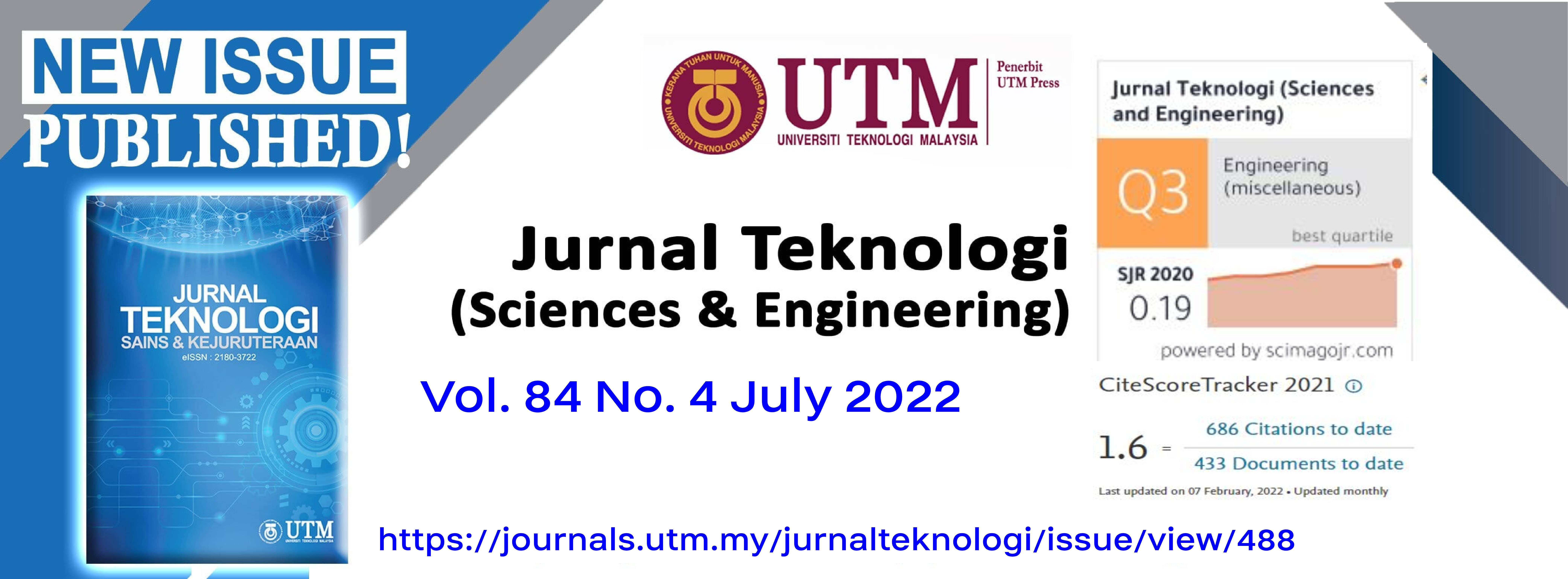NUMERICAL COMPUTATION OF LIGAND AND SIGNAL ASSOCIATED TO INVADOPODIA FORMATION
DOI:
https://doi.org/10.11113/jurnalteknologi.v84.17901Keywords:
Finite difference, free boundary, ghost fluid, level set, invasive cancer cellAbstract
Invadopodia are protrusions that are commonly spotted at the plasma membrane of the invasive cancer cells. In forming invadopodia, several molecular interactions are involved such as the ligand, extracellular matrix (ECM), matrix metalloproteinases (MMPs), actin, and signal which are interrelated. In this paper, the mathematical model of ligand and signal transduction is taken in the heat equation with the MMPs is set as function . Besides, the actin regulation moved the interface and thus computed as the signal gradient. The mathematical model is solved using the combination of methods finite difference, ghost fluid with linear extrapolation, and level set. Apart from that, the convergence results are also given to determine the effectiveness of the above-mentioned methods. Results showed that the stimulation of signal transduction from the ligand and membrane-associated receptor binding consequently moved the plasma membrane. Also, the methods used gave a good agreement in the convergence results.
References
Parekh, A., Ruppender, N. S., Branch, K. M. Sewell-Loftin, M. K., Lin, J., Boyer, P. D. et al. 2011. Sensing and Modulation of Invadopodia Across a Wide Range of Rigidities. Biophys. J. 100(3): 573-82.
DOI: http://dx.doi.org/10.1016/j.bpj.2010.12.3733.
Parekh, A. and Weaver, A.M. 2016. Regulation of Invadopodia by Mechanical Signaling. Exp. Cell Res. 343(1): 89-95.
DOI: https://doi.org/10.1016/j.yexcr.2015.10.038.
Sibony-Benyamini, H. and Gil-Henn, H. 2012. Invadopodia: the Leading Force. Eur. J. Cell Biol. 91(11-12): 896-901.
DOI: https://doi.org/10.1016/j.ejcb.2012.04.001.
Enderling, H., Alexander, N., Clark, E., Branch, K., Estrada, L., Crooke, C. et al. 2008. Dependence of Invadopodia Function on Collagen Fiber Spacing and Cross-Linking: Computational Modeling and Experimental Evidence. Biophys. J. 95: 2203-18.
DOI: https://doi.org/10.1529/biophysj.108.133199.
Eckert, M. A., Lwin, T. M., Chang, A. T., Kim, J., Danis, E., Ohno-Machado, L. et al. 2011. Twist1-Induced Invadopodia Formation Promotes Tumor Metastasis. Cancer Cell. 19(3): 372-86.
DOI: http://dx.doi.org/10.1016/j.ccr.2011.01.036.
Yamaguchi, H. 2012. Pathological Roles of Invadopodia in Cancer Invasion and Metastasis. Eur. J. Cell Biol. 91: 902-7. DOI: https://doi.org/10.1016/j.ejcb.2012.04.005.
Eddy, R., Weidmann, M., Sharma, V., Condeelis, J. 2017. Tumor Cell Invadopodia: Invasive Protrusions that Orchestrate Metastasis. Trends Cell Biol. 27.
DOI:https://doi.org/10.1016/j.tcb.2017.03.003.
Saitou, T., Rouzimaimaiti, M., Koshikawa, N., Seiki, M., Ichikawa, K., Suzuki, T. 2012. Mathematical Modeling of Invadopodia Formation. J. Theor. Biol. 298:138-46.
DOI:https://doi.org/10.1016/j.jtbi.2011.12.018.
Admon, M. A. 2015. Mathematical Modeling and Simulation in an Individual Cancer Cell Associated with Invadopodia Formation. PhD Thesis. Osaka University.
Admon, M. A. and Suzuki, T. 2017. Signal Transduction in the Invadopodia Formation using Fixed Domain Method. J. Phys. Conf. Ser. 890: 12036.
DOI: http://dx.doi.org/10.1088/1742-6596/890/1/012036.
Noor Azhuan, N. A., Poignard, C., Suzuki, T., Shafie, S., and Admon, M. A. 2019. Two-dimensional Signal Transduction during the Formation of Invadopodia. MALAYSIAN J. Math. Sci. 13(2): 155-64.
Gallinato, O., Ohta, M., Poignard, C., and Suzuki, T. 2017. Free Boundary Problem for Cell Protrusion Formations: Theoretical and Numerical Aspects. J. Math. Biol. 75(2): 263-307. DOI: https://doi.org/10.1007/s00285-016-1080-7.
Yaacob, N., Noor Azhuan, N. A., Shafie, S., and Admon, M. A. 2019. Numerical Computation of Signal Stimulation from Ligand-EGFR Binding during Invadopodia Formation. Matematika. 35(4): 139-48.
DOI: https://doi.org/10.11113/matematika.v35.n4.1268.
Strychalski, W., Adalsteinsson, D., and Elston, T. 2010. Simulating Biochemical Signaling Networks in Complex Moving Geometries. SIAM J. Sci. Comput. 32(5): 3039-70. DOI: https://doi.org/10.1137/090779693.
Shaikh, J., Bhardwaj, R., and Sharma, A. 2015. A Ghost Fluid Method Based Sharp Interface Level Set Method for Evaporating Droplet. Procedia IUTAM. 15: 124-31.
DOI: https://doi.org/10.1016/j.piutam.2015.04.018.
Osher, S., and Sethian, J. A. 1988. Fronts Propagating with Curvature-dependent Speed: Algorithms based on Hamilton-Jacobi Formulations. J. Comput. Phys. 79(1): 12-49.
DOI: https://doi.org/10.1016/0021-9991(88)90002-2.
Sethian, J. A. and Adalsteinsson, D. 1999. The Fast Construction of Extension Velocities in Level Set Methods. J. Comput. Phys. 148: 2-22.
DOI: https://doi.org/10.1006/jcph.1998.6090.
Chen, S., Merriman, B., Osher, S., and Smereka, P. 1997. A Simple Level Set Method for Solving Stefan Problems. J Comput. Phys. 135(1): 8-29.
DOI: https://doi.org/10.1006/jcph.1997.5721.
Tan, L. and Zabaras, N. 2007. A Level Set Simulation of Dendritic Solidification of Multi-component Alloys. J. Comput. Phys. 221(1): 9-40.
DOI: https://doi.org/10.1016/j.jcp.2006.06.003.
Tan, L. and Zabaras, N. 2006. A Level Set Simulation of Dendritic Solidification with Combined Features of Front-tracking and Fixed-domain Methods. J. Comput. Phys. 211(1): 36-63
DOI: http://dx.doi.org/10.1016/j.jcp.2005.05.013.
Tan, L. and Zabaras, N. 2007. Modeling the Growth and Interaction of Multiple Dendrites in Solidification using a Level Set Method. J. Comput. Phys. 226(1): 131-55.
DOI: https://doi.org/10.1016/j.jcp.2007.03.023.
Wilder, J. W., Clemons, C., Golovaty, D., Kreider, K. L., Young, G. W., and Lillard R. S. 2015. An Adaptive Level Set Approach for Modeling Damage Due to Galvanic Corrosion. J. Eng. Math. 91(1): 121-42.
DOI: http://dx.doi.org/10.1007/s10665-014-9732-3.
Bajger, P., Ashbourn, J. M. A., Manhas, V., Guyot, Y., Lietaert, K., and Geris, L. 2017. Mathematical Modelling of the Degradation Behaviour of Biodegradable Metals. Biomech. Model Mechanobiol. 16(1): 227-38.
DOI: https://doi.org/10.1007/s10237-016-0812-3.
Guyot, Y., Papantoniou, I., Chai, Y. C., Van Bael, S., Schrooten, J., and Geris, L. 2014. A Computational Model for Cell/ECM Growth on 3D Surfaces using the Level Set Method: A Bone Tissue Engineering Case Study. Biomech. Model Mechanobiol. 13(6): 1361-71.
DOI: https://doi.org/10.1007/s10237-014-0577-5.
Yaacob, N., Shafie, S., Suzuki, T., and Admon, M. A. 2021. Level Set Method for Free Boundary of Invasive Cancer Cell using Different Functions of Matrix Metalloproteinases. J. Phys. Conf. Ser. 1988(1): 012020.
Downloads
Published
Issue
Section
License
Copyright of articles that appear in Jurnal Teknologi belongs exclusively to Penerbit Universiti Teknologi Malaysia (Penerbit UTM Press). This copyright covers the rights to reproduce the article, including reprints, electronic reproductions, or any other reproductions of similar nature.
















